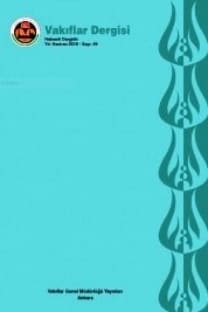Osmanlı Kayıt Kültüründe Vakıf Muhasebesi ve Devlet Muhasebe Sistemi
Osmanlı İmparatorluğu’nda vakıfların iki önemli dayanağı vardır. Bunlardan ilki hukuk düzenidir. İkincisi de muhasebe kontrolüdür. Muhasebe kontrolü, vakfın bulunduğu yerde tutulan muhasebenin yıllık gelir ve gider kayıtlarının, kadı kontrolünden geçtikten sonra merkez muhasebesine gelmesi ve orada gelir gider defterinin yeniden düzenlenmesi şeklinde olmaktadır. Devlet muhasebesinde kullanılan merdiven yönteminin vakıf muhasebesinde kullanılması bir istisna teşkil eder. Merkezî vakıf muhasebesinin içinde bulunduğu Osmanlı’nın merkezî devlet muhasebesi büyük bir örgüttür ve bu örgüt, devlet muhasebesinde yıllık kesin gelir ve gider hesabını düzenlemek, devlet hazinesini yönetmek ve sürekli denetleme yapmak sureti ile görevini sürdürür.
Anahtar Kelimeler:
Osmanlı İmparatorluğu, devlet muhasebesi, vakıf muhasebesi
Waqfs and State Accounting Systems in the Ottoman Administration
Waqfs in the Ottoman Empire are established on two baselines. The first one is the legal order and the second is the governance of accountancy. Accounting is controlled by sending the annual revenue and expenditure records of the waqfs to central accountancy after audited by the kadı. Afterwards, revenue and expenditure journals are rearranged according to the outcome of the auditing activities. The usage of the state accounting method titled merdivan in waqf accountancy is an exceptional situation. Central accountancy organization of the Ottoman Empire is a great structure that embodies central waqf accountancy . This central accountancy records the exact annual revenues and expenditures of the state, administrates state treasury, and continuously performs auditing activities.
Keywords:
Ottoman Empire, state accountancy, accounting of waqfs,
___
- Akgündüz, Ahmet. (1992). Osmanlı Kanunnameleri. Osmanlı Araştırmaları Vakfı Yayınları. (4.Kitap). İstanbul.
- Barkan, Ömer Lütfi (1962-63). “Osmanlı İmparatorluğu’nda İmaret Sitelerinin Kuruluş ve İşleyişi Tarzına Dair Araştırmalar”. İktisat Fakültesi Mecmuası. (23). İstanbul. s. 1-2.
- D' Ohsson, I.M. (1787-1820). Tableau General de L’Empire Othoman. (3. Kitap). s. 342-379.
- Güvemli, Oktay ve Fatma Şensoy (2013). “The Accounting Records at Mukataas and the Example of Bursa Mukataa from 16th Century”. 3rd Balkans and Middle East Countries Conference on Auditing and Accounting History (3BMAC). İstanbul. s. 1139.
- Güvemli, Oktay (2000). Türk Devletleri Muhasebe Tarihi, Osmanlı İmparatorluğu, Tanzimat’a Kadar. (2). 2. Baskı. İstanbul. s. 374- 398.
- Güvemli, Oktay ve Cengiz Toraman (2013). Risale-i Felekiyye-Kitab-us Siyakat. İstanbul. s.15.
- Güvemli, Oktay ve Batuhan Güvemli (2007). “The Birth and Development of an Accounting Method in the Middle East”. The Fifth Accounting History International Conference. Banf – Kanada. s. 9-11.
- Güvemli, Oktay ve Güvemli, B. (2015). “Osmanlı Devlet Muhasebesinde Kayıt Düzeni ve Defter Sistemi”. Muhasebe ve Finans Tarihi Araştırmaları Dergisi. (9). s.27.
- Güvemli, Oktay, Cengiz Toraman ve Batuhan Güvemli (2014). Osmanlı İmparaorluğu’nda Devlet Muhasebesi” Anadolu Kayıt Kültürü. Kamu Gözetimi Muhasebe ve Denetim Standartları Kurumu Yayınları. Ankara. s. 371-400.
- Şensoy, Fatma (2016). “Osmanlı İmparatorluğu’nda Vakıfların Ekonomik Boyutları”. Muhasebe ve Finans Tarihi Araştırmaları Dergisi. (10). s. 43.
- Emecen, Feridun (1994). “Başbâki Kulu”. Türkiye Diyanet Vakfı İslam Ansiklopedisi. (3). s. 34.
- ISSN: 1011-7474
- Başlangıç: 2015
- Yayıncı: Mehmet Kurtoğlu
Sayıdaki Diğer Makaleler
Beyrut Hz. Ömer Camii Vakfı (1840-1898)
Taceddin Dergâhında İstiklâl Şairi Mehmet Âkif
Tarihçilerin Kutbu Halil İnalcık’ın Gözüyle Vakıf Kurumu
Osmanlı Dönemi’nde Rize ve Çevresinde Kurulan Para Vakıfları (1859-1913)
Osmanlı Kayıt Kültüründe Vakıf Muhasebesi ve Devlet Muhasebe Sistemi
Oktay GÜVEMLİ, Batuhan GÜVEMLİ
Fatih ve II. Bayezid Ümerâsından Yakup Bey ve Vakıfları
Mukaddime-i İbn-i Haldun Tercümesi, İndeksli Tıpkıbasım
